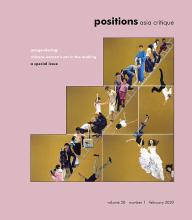"Camouflaged Histories: Lei Yan as Chinese Guerrilla Girl" appears in (En)gendering: Chinese Women's Art in the Making, a special issue of positions: asia critique guest edited by Shuqin Cui.
Abstract: Lei Yan 雷燕 , whose artistic practice was shaped by a decades-long career in the Chinese military, began a period of transition through participation in a 2002 restaging of the Communist Red Army’s 1934 Long March as a multi-sited international art project. Her resulting encounter with U.S. feminist art icon Judy Chicago raised questions about the potential neocolonial influence of global feminist art. The work Lei subsequently produced performs an auto-ethnographic excavation of the socio-historical categories—woman soldier, military artist, and woman artist—that made her as both artist and woman. She works from within a national representational corpus, subjecting it to various experiments to reveal the fields of violence has enacted from the Sino-Vietnamese War to the Sichuan earthquake. Lei Yan’s meditation through photography upon national, revolutionary iconography evolved into soft sculpture objects in cloth and paper. Their arrested ephemerality decenters the human subject, drawing attention to haunting absences in conventional stories of art, feminism, and nation. In comparison with the monumental work of Ai Weiwei 艾未未 , who also created pieces in response to the Sichuan earthquake, Lei’s art serves not to admonish but to bring back into consciousness lost lives and camouflaged histories.
